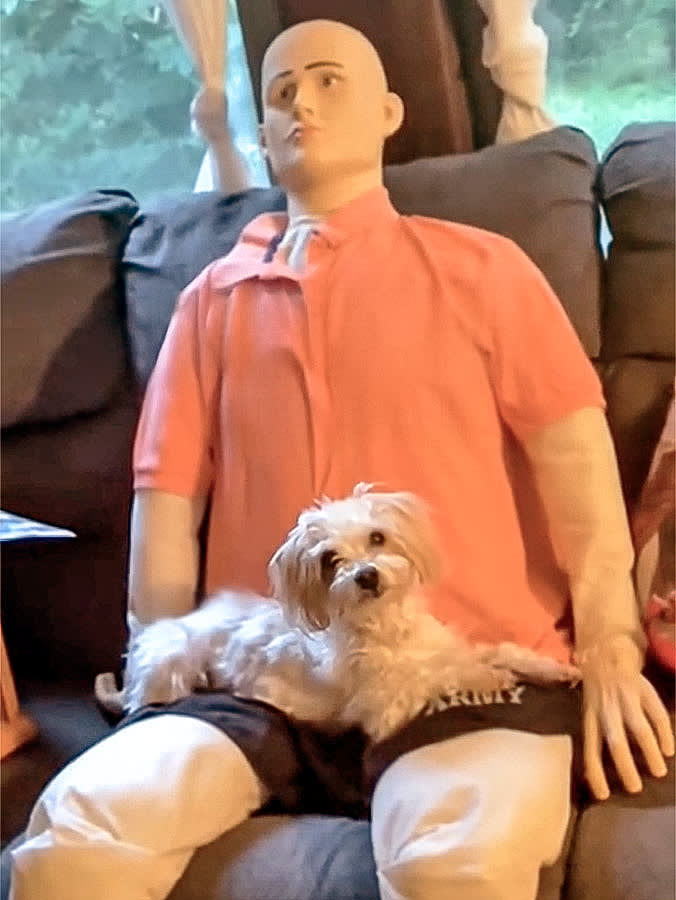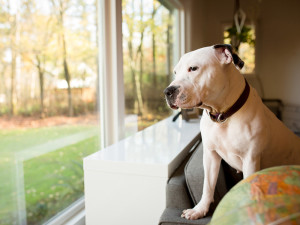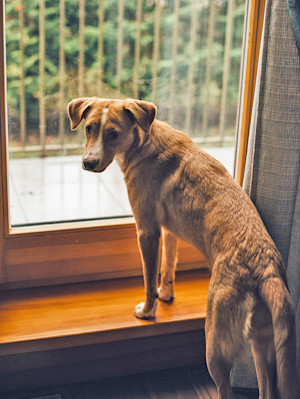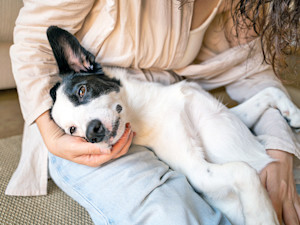Are These Creepy Life-Sized Dolls the Cure to Your Dog’s Separation Anxiety?
Shark Tank and TikTok seem to think so.

Share Article
On a recent episode of Shark Tank, entrepreneur and dog-lover Todd Schram introduced the sharks to Gerty, a life-sized, human-shaped, slightly unnerving inflatable doll. Gerty, Schram explained, could be used to soothe dogs who are left home alone. He’d created the doll when his own dog was suffering from separation anxiety; by dressing the doll up in his own clothes and introducing it to his pup as if it were a human, he was able to eliminate his dog’s stress over being left behind.
“She has the emotional warmth of a human, and the maintenance of a beach ball,” Schram told the panel. “But the most important thing about Gerty is that she actually works.”
And Schram had plenty of positive reviews to back him up. Despite Robert Herjavec calling the doll “scary” and “so weird,” Kevin O’Leary eventually agreed to give Schram $50,000 for 30 percent equity. Since the episode aired, the Gerty doll has already upped its game — you can now buy opens in new tab a customizable version with a photo of your face printed onto the head. Curious consumers can snag the non-custom option for $50 (or on sale for $40) and the personalized version for $65.
Before there was Gerty, there was Farc.
Gerty is new, but the concept isn’t. For the past few years, pet parents and rescues have been using mannequins to soothe their dogs, with many sharing their experiences on social media. In 2019, six years before there was Gerty, there was Farc. It was purchased from Vintage Pet Rescueopens in new tab for Shorty, a Bulldog who was inconsolable when her dad, Marc, traveled (Farc equals Fake Marc). Not only did Shorty fall in love with Farc, but many pets at Vintage Pet Rescue, where Farc has resided since Shorty’s passing, have taken to cuddling up on the mannequin’s lap. It’s some seriously adorable stuff.
How much do you spend on your pet per year?

All these videos are undoubtedly cute — but are they based in science? We talked to experts about whether or not dolls can really relax pets who are left alone.
Do these dolls actually work as a separation anxiety cure?
The expert consensus? Not really. While some dogs might love hanging out with a mannequin, it’s not a great first-effort treatment for separation anxiety — and it definitely doesn’t replace the presence of a human or the usefulness of a long-term plan.
“True canine separation anxiety isn’t about loneliness — it’s about panic. Dogs with this condition become distressed when they can’t see, follow, or access their primary attachment figure,” Alexandra Bassettopens in new tab, a separation anxiety specialist, tells Kinship. “While I’ve seen one or two anecdotal stories about dolls helping, that’s not typical.”
And no, you’re definitely not fooling your pet into thinking you’re still home, no matter how stinky the T-shirt is that you dress the doll in. Even if your dog is soothed by a doll, they definitely don’t think it’s human. “Dogs don’t mistake dolls for people in the way we might imagine. If a dog seems calmer around a doll, it may be because of the doll’s size, scent (if the guardian has handled it), or even just the novelty of having an object in the room,” Bassett says.
In some cases, resorting to a doll might even be counterproductive. “When we think about starting to minimize separation anxiety in our dogs, we want to reassure them that being alone is OK and safe, and that we will return,” dog trainer Paige Gordon says. Leaving behind a substitute “person” doesn’t get to the root of the problem — and it might even confuse or stress out certain pets.
Above all, experts agree that a doll shouldn’t be a pet parent’s first and only effort. Bassett worries that dolls might provide false hope, which can postpone an adequate intervention. “Guardians might delay getting their dog the proper help if they’re relying on something that isn’t proven to work,” she says.
And even if a doll does work for your dog, you shouldn’t lean on it too heavily. “Keep in mind that the doll is not a substitute for human care or attention,” animal expert Maxwell Martinson says. “Don’t spend longer periods of time away from your dog just because you have the doll.”
That said, a doll can sometimes provide temporary comfort — and as TikTok proves, some pups truly adore them. The familiarity of your scent can help some pets relax, and like any new toy or bed, a doll can be an exciting addition to a pet’s living space. Even if a doll doesn’t convince your pet that you’re still around or cure their anxiety altogether, it may provide some level of comfort. “It’s similar to the hum of a box fan while you’re trying to sleep, or a body pillow,” Martinson says. “Something familiar to help you stay calm, even if you know it’s not real.”
What can you try first?
Dolls and mannequins are being advertised as quick-acting miracle cures, but the reality is that treating separation anxiety is a long process. The good news is that there are a variety of evidence-based methods proven to work.
Create a routine.
First, dogs crave a routine. Consistency can greatly reduce stress. “Even if your dog has separation anxiety, being reliable with your separation is the first step in giving your dog a dependable environment,” Martinson says.
Crate-train.
Crate-training is another useful tool; providing your pet with a cozy space they can retreat to can do wonders. “It would be stressful for a human, but dogs can actually see their crate as a comfortable, safe space,” Martinson says. If you adopt your dog as a puppy, early crate training is ideal.
Start slowly.
Building up to long separations slowly is a useful technique. You can try leaving your dog along for short periods, slowly building up to longer stretches of time. Keeping your exit lowkey (as tempted as you may be to give your pup one million kisses before you leave) can also help.
Try supplements.
If training methods aren’t working alone, it may be worth consulting your veterinarian about adding a calming supplement to your dog’s diet. A variety of products containing natural ingredients from chamomile to CBD have proven to help some pups relax. In extreme cases, a veterinarian may prescribe a dog anti-anxiety medication.
Hire a trainer.
For pups with severe anxiety, it’s worth turning to the pros. “Working with a certified trainer or behaviorist ensures you’re using proven methods tailored to your dog’s specific needs,” Bassett says.
In short, there’s no miracle cure and no one product that can keep your pet happy. Consistent training is key — and nothing can replace quality time with a real flesh-and-blood human. But if you’re already using evidence-based training methods and you like the idea of your pup cuddling with a doll while you’re away, it’s probably harmless. And really, really cute. And kind of creepy. But mostly cute.

Sio Hornbuckle
Sio Hornbuckle is the Assistant Editor at Kinship, where they frequently write for the site. As a writer, they specialize in pet news, animal science, and pop culture. They live in New York City with their cat, Toni Collette.
Related articles
![Muscular white pit bull stands on couch, looking out window to sunny fall day.]()
Separation Anxiety in Dogs
Does your dog freak out when you head for the door? Here’s some advice.
![Sad dog waiting by window at home.]()
6 Lies You've Been Told About Your Dog’s Separation Anxiety
Remember, it’s not your fault, no matter what anyone says.
![Sad dog waiting by the window at home.]()
Pets Experience Empty-Nest Syndrome, Too
Kids of any age, really, going back to school can can have an affect on your pet.
![Woman cuddling her dog at home.]()
Is Your Pet Actually Stressed Out, or Are You Just Projecting?
How to know when it’s real—and time to call the vet.
Why Is Your Dog Hiding Under the Bed?
It must be comfy under there.
![Golden Retrieve dog running in the grass outside, playfully chasing a flirt pole held by a man in blue jeans]()
How to Tell if Your Dog Is Bored
Get out the toys and puzzles.





